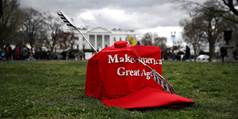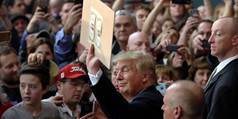What Next for the US Stock Market?
August 22 marked the longest period of rising share prices in US history. But the stock market's nine-year bull run won't last much longer, as three factors drive up long-term interest rates, reducing the present value of future corporate profits and providing investors with an alternative to equities.

The Depth of the Next US Recession
Whatever the immediate trigger of the next US recession, the consequences are likely to be severe. With the US government committed to pro-cyclical fiscal, macro-prudential, and even monetary policies, the authorities are in a weak position to manage the next inevitable shock.
ASPEN, COLORADO – The United States economy is doing well. But the next recession – and there is always another recession – could be very bad.
The US Bureau of Economic Analysis estimates that GDP growth in the second quarter of 2018 reached 4.1% – the highest since the 4.9% seen under President Barack Obama in 2014. Another year of growth will match the record ten-year expansion of the 1990s. Add to that low unemployment, and things are looking good.
But this cannot continue forever. Given massive global corporate debt and a soaring US stock market – the cyclically adjusted price-to-earnings ratio is high by historical standards – one possible trigger for a downturn in the coming years is a negative shock that could send securities tumbling.
That shock could be homegrown, coming in the form, say, of renewed inflation or of the continued escalation of the trade war that US President Donald Trump has started. The shock could also come from abroad. For example, the current financial and currency crisis in Turkey could spread to other emerging markets. The euro crisis is not truly over, despite the completion of Greece’s bailout program, with Italy, in particular, representing a major source of risk. Even China is vulnerable to slowing growth and high levels of debt.
Whatever the immediate trigger, the consequences for the US are likely to be severe, for a simple reason: the US government continues to pursue pro-cyclical fiscal, macro-prudential, and even monetary policies. While it is hard to get counter-cyclical timing exactly right, that is no excuse for pro-cyclical policy, an approach that puts the US in a weak position to manage the next inevitable shock.
During economic upswings, the budget deficit usually falls, at least as a share of GDP. But with the US now undertaking its most radically pro-cyclical fiscal expansion since the late 1960s, and perhaps since World War II, the Congressional Budget Office projects that the federal government’s fast-growing deficit will exceed $1 trillion this year.
America’s deficit is being blown up on both the revenue and expenditure sides. Although a reduction in the corporate tax rate was needed, the tax bill that Congressional Republicans enacted last December was nowhere near revenue-neutral, as it should have been. Like the Republican-led governments of Ronald Reagan and George W. Bush, the Trump administration claims to favor small government, but is actually highly profligate. As a result, when the next recession comes, the US will lack fiscal space to respond.
The Trump administration’s embrace of financial deregulation is also pro-cyclical and intensifies market swings. The Trump administration and the Republican-controlled Congress have gutted Obama’s fiduciary rule, which would have required professional financial advisers to put their clients’ interests first when advising them on assets invested through retirement plans. They have also rolled back sensible regulations of housing finance, including risk-retention rules, which force mortgage originators to keep some “skin in the game,” and requirements that borrowers make substantial down payments, which work to ensure ability to pay.
The White House and Congress have also been acting to gut the 2010 Dodd–Frank Wall Street Reform and Consumer Protection Act, which strengthened the financial system in several ways, including by imposing higher capital requirements on banks, identifying “systemically important financial institutions,” and requiring more transparency in derivatives. The Consumer Financial Protection Bureau – established by Dodd-Frank to protect borrowers with payday, student, and car loans – is also now being curtailed.
Like most major legislation, Dodd-Frank could be improved. Compliance costs were excessive, especially for small banks, and the original threshold for stress-testing “too big to fail” institutions – $50 billion in assets – was too low. But the current US leadership is going too far in the other direction, including by raising the threshold for stress tests to $250 billion and letting non-banks off the hook, which increases the risk of an eventual recurrence of the 2007-2008 financial crisis.
Now is the right point in the cycle to raise banks’ capital requirements as called for under Dodd-Frank. The cushion would minimize the risk of a future banking crisis.
Other countries do macro-prudential policy better. Europeans have applied the counter-cyclical capital buffer to their banks. Some Asian countries raise banks’ reserve requirements and homeowners’ loan-to-value ceilings during booms, and lower them during financial downturns.
When it comes to monetary policy, the US Federal Reserve has been doing a good job; but its independence is increasingly under attack from Republican politicians. If this assault succeeds, counter-cyclical monetary policy would be impaired.
In the past, the Fed has moderated recessions by cutting short-term interest rates by around 500 basis points. But, with those rates currently standing at only 2%, such a move is impossible. That is why, as Martin Feldstein recently pointed out, the Fed should be “raising the rate when the economy is strong,” thereby giving “the Fed room to respond in the next economic downturn with a significant reduction.”
Most Fed critics disagree. In 2010, they attacked the Fed for its monetary easing, even though unemployment was still above 9%. Now Trump says he is “not thrilled” about the Fed raising interest rates, even though unemployment is below 4%. This is tantamount to advocating pro-cyclical monetary policy.
As we approach the tenth anniversary of the global financial crisis, we should recall how we got there. In 2003-2007, the US government pursued fiscal expansion and financial deregulation – an approach that, even at the time, was recognized as likely to constrain the government’s ability to respond to a recession. If the US continues on its current path, no one should be surprised if history repeats itself.

Are Trump’s Policies Hurting Long-Term US Growth?
When it comes to economic performance, US presidents have considerably more influence over long-term trends than over short-term fluctuations. And it is by this standard that Donald Trump's administration should be judged.
CAMBRIDGE – President Donald Trump regularly thumps his chest and claims credit for each new uptick of the fast-growing US economy. But when it comes to economic performance, US presidents have considerably more influence over long-term trends than over short-term fluctuations.
To be sure, Trump’s tax cuts and spending hikes have provided some extra short-term stimulus. So too, apparently, have foreign buyers of US products such as soybeans, who are rushing to stock up before the tariff war fully heats up. Still, it is not easy to speed up a $20 trillion economy, even by running a budget deficit of nearly $1 trillion, as Trump’s administration is doing. In fact, short-term fluctuations in business inventories have arguably held down growth as much as other factors have temporarily propped it up.
In a cantankerous political environment, it is not easy to think about the long term. But, thanks to the magic of compound interest, measures that marginally raise long-term growth matter a lot. For example, the transportation deregulation policies of President Jimmy Carter’s administration in the late 1970s set the stage for the Internet retail revolution. President Ronald Reagan’s massive tax cuts in the 1980s helped restore US growth in the ensuing decades (but also exacerbated inequality trends). And President Barack Obama’s efforts (and before him President George W. Bush’s) to contain the damage from the 2008 financial crisis underpin the strong economy for which Trump wants to take full credit.
What will be the cumulative effect of Trump’s economic policies on the economy ten years from now? Political ruckus aside, the jury remains out.
Let’s start with the likely positive side of the ledger. The end-2017 corporate tax reform was one of those rare instances where the US Congress comprehensively streamlined and improved the US’s Byzantine tax system, though the corporate tax rate should have been set at 25%, not 21%.
Obama would likely have been very happy to pass a similar bill. But, during his presidency, the Republican-controlled Congress insisted that any proposal had to be “revenue neutral” even in the short term, which is a tough political hurdle for any fundamental tax reform. Trump’s efforts to scale back regulation, particularly on small and medium-size businesses, are probably also a plus for long-term growth, reversing some excesses that crept in at the end of Obama’s term (though Trump is throwing out good regulations with bad ones).
One little-noticed area where the Trump administration seems to be trying out fresh thinking is the retraining of displaced workers and the improvement of vocational training at the high-school level. In principle, technology and big data allow the federal government to help provide better information to parents and workers on what skills are most in demand, and well as the geographic location of jobs.
The president’s daughter, Ivanka Trump, is spearheading the effort. While it is easy to be cynical (some say the new program is just an excuse to cut funds from existing retraining programs), the idea that digital platforms can massively improve re-education and training is a good one.
But while the Trump administration has strengthened the US economy’s long-term growth potential in some ways, the other side of the ledger is rather grim. For starters, a wide range of studies – from the work of the late economist David Landes to more recent research by MIT’s Daron Acemoglu and the University of Chicago’s James A. Robinson – find that institutions and political culture are the single most important determinants of long-term growth. Recovery from the damage Trump is inflicting on institutions and political culture in the US may take years; if so, the economic costs could be considerable.
Moreover, in accordance with the administration’s disdain for science, the proposed budgets for basic research, including for the National Institutes of Health and the National Science Foundation, were reduced sharply (fortunately, the US Congress rejected the cuts). And anti-trust enforcement, needed to counter excessive monopoly power in many parts of the economy, is essentially dormant. That will exacerbate inequality over the long term; Trump’s coal mines and trade tariffs are at best band-aids on a bullet wound.
Last, but not least, many of the regulations that Trump is targeting ought to be strengthened, not eliminated. It is hard to imagine that gutting the Environmental Protection Agency and withdrawing from the Paris climate agreement are helpful for long-run growth, given that the costs of cleaning up pollution later vastly exceed the costs of mitigating it today.
As for financial regulation, the reams of new rules adopted after the 2008 financial crisis have been a dream come true for lawyers. Rather than try to micromanage banking, it would be far better to ensure that shareholders have more “skin in the game,” so that big banks are more inclined to avoid excessive risk. On the other hand, neutering existing legislation without putting anything adequate in its place sets the stage for another financial crisis.
So, although the US economy is indeed growing rapidly, the full extent of Trump’s economic legacy might not be felt for a decade or more. In the meantime, should a downturn come, it will not be Trump’s fault – at least according to Trump, who is already gearing up to blame the US Federal Reserve for raising interest rates and ruining all his good work.

Trump’s Strong-Dollar Weakness
The Trump administration would like us to believe that the dollar’s rise reflects faster economic growth, driven by deregulation, tax cuts, and expanded defense spending. But, if anything, Trump's economic agenda is creating inflationary pressure and undercutting the "exorbitant privilege" that the dollar has long conferred on the US.
SANTA BARBARA – Having gained more than 8% in value since the start of the year, the US dollar is nearing highs not seen in more than a decade, and market indicators point to even more appreciation in the coming months.
At first blush, this would seem to vindicate US President Donald Trump, who came to office pledging to “Make America Great Again.” A stronger dollar could be taken to mean that his pro-growth economic policies are working. Yet a closer look shows that matters are more complicated; in fact, Trump could precipitate a great decline in the dollar.
For starters, it is not at all clear that Trump can take much credit for the dollar’s appreciation. But even if he could, a strong greenback is not necessarily good for his policy objectives; nor is the exchange rate even an accurate measure of the currency’s true strength.
The Trump administration would like us to believe that the dollar’s rise reflects faster economic growth, driven by the president’s agenda of deregulation, massive tax cuts, and substantially expanded defense spending. After years of mismanagement, we are told, the government has now succeeded in restoring business confidence; America is finally living up to its potential.
But most knowledgeable economists would attribute the dollar’s appreciation to rising interest rates. In an effort to head off inflation, the US Federal Reserve has already increased its federal funds rate twice this year, and signaled two more increases before the end of 2018. When US interest rates rise, more investment capital flows in, driving up demand for the dollar. And right now, money is pouring into the United States from every corner of the globe.
The situation today is not unlike that of Trump’s Republican predecessors. Former Presidents Ronald Reagan and George W. Bush also each cut taxes sharply, resulting in budget deficits that prompted the Fed to raise interest rates. In each case, the dollar appreciated dramatically (by as much as 60% under Reagan between 1981 and 1985). Today, the Fed is once again acting independently to ward off the inflationary effect of fiscal expansion. Thus, if anyone should take credit for the dollar’s appreciation, it is the Fed.
Nevertheless, one can imagine Trump saying that weaker currencies are for “losers.” And he may brag about the soaring dollar in his ongoing confrontation with Turkish President Recep Tayyip Erdoğan, whose country’s own currency has fallen by almost 60% since the start of the year. But while a strong dollar exchange rate might appeal to Trump’s ego, it doesn’t necessarily serve his broader agenda.
After all, a strengthening dollar increases the price of exports abroad and lowers the domestic cost of imports, thus discouraging the former and encouraging the latter. That is directly at odds with Trump’s stated goal of reducing the US trade deficit.
Trump’s obsession with the trade deficit has led him to impose import tariffs on steel, aluminum, and a wide range of products from China. But, ironically, more expensive imports will also put upward pressure on the domestic inflation rate, which could force the Fed to raise interest rates even faster than planned. That, in turn, would produce still more dollar appreciation and even bigger trade deficits, as happened under Reagan and Bush.
Finally, one must remember that short-term movements in foreign-exchange markets are no way to judge a currency’s underlying strength. Longer-term trends in how a currency is used internationally – particularly as a store of value for foreign investors or central banks – are far more telling.
For decades, no currency has been more widely used than the dollar. Owing to its dominance, the US has long enjoyed what former French President Valéry Giscard d’Estaing famously described as an “exorbitant privilege.” As long as foreigners are hungry for dollars, the US can spend whatever it needs to project power around the world. To pay for it all, it need only turn on the printing press.
But Trump’s belligerent policies are putting this privileged position at risk. His protectionist promise to put “America first” smacks of xenophobic nationalism, and his bullying use of tariffs is alienating friends and foes alike. The longer he maintains such policies, the more likely it is that markets will gradually move toward alternatives to the dollar. Eventually, the dollar would slowly bleed out, and America’s exorbitant privilege and global influence would evaporate.
As it happens, China has already convinced Russia to accept the renminbi as payment for natural gas, where once it made such purchases only in dollars. And, more recently, China has started preparing the way for purchases of imported crude oil in renminbi. For example, earlier this year, it launched a new oil futures market in Shanghai, which seems intended to establish a renminbi-denominated price benchmark alongside Brent and West Texas Intermediate crude. If successful, the Shanghai market could trigger a shift of payments for other traded commodities as well – all at the dollar’s expense.
Likewise, a number of countries are looking for ways to circumvent the Trump administration’s sanctions on Iranian oil producers. India, for example, already pays for some Iranian oil with commodities rather than dollars. And both Russia and China have been investing heavily in gold to reduce their reliance on dollar-denominated reserves. Between them, the two countries have already bought some 10% of all the gold available on the world market.
So, despite today’s dollar appreciation, a weakening greenback may be in store over the long term. Far from making America great again, Trump seems to be hastening its economic decline.


CAMBRIDGE – The US stock market achieved its longest rise in its history on August 22, with the Standard and Poor’s 500 index up by 230% since 2009. Although this wasn’t the biggest increase in a bull market, it marked the longest period of increasing share prices.
Several forces contributed to this impressive nine-year run. The primary driver has been the extremely low interest rates maintained by the Federal Reserve. The Fed cut its short-term federal funds rate to near-zero in 2008 and did not begin to increase it above 1% until 2017. Even now, the federal funds rate is lower than the annual inflation rate. The Fed also promised to keep the short rate low for a long period of time, causing long-term rates to remain low as well. With interest rates so low for so long, investors seeking higher returns bought shares, driving up their prices.
A rational model of share prices sets them equal to the present value of future profits. Low interest rates raised the present value of future profits, and the corporate tax reform enacted at the end of 2017, together with deregulation in several industries, has raised both current profits and expected future profits, contributing to the present value of future profits.
But even with rising profits, low interest rates have caused share prices to increase faster than profits. As a result, the S&P price-earnings ratio is now more than 50% higher than its historic average.
With real (inflation-adjusted) GDP rising at more than 3% this year, the strength of the US economy has induced foreign investors to shift their holdings to US equities. And in recent months, US households that had not owned stocks in the past, fearful of missing out on the bull market, have joined the equity bandwagon.
But what of the future? Stock-market booms don’t die of old age; they are generally killed by higher interest rates. That often happens when the Fed raises the short-term interest rate to stop or reverse rising inflation. Although the Fed’s preferred rate of inflation – the price of consumer expenditures – has just reached its target of 2%, other measures of price growth are rising more rapidly. The overall Consumer Price Index (CPI) is now 2.9% higher than it was a year ago. Even “core” consumer inflation, which strips out more volatile food and energy prices, has increased by 2.4% over the past year.
The Fed’s short-term interest rate is now just 1.75%, implying that the real rate is still negative. The Fed’s Open Market Committee has now projected that it will raise the federal funds rate to 2.4% by the end of 2018, to 3.1% by the end of 2019, and to 3.4% by the end of 2020.
My judgment is that the greatest risk to the stock market is the future increase in long-term interest rates. The interest rate on ten-year Treasury bonds is now about 2.9%, implying a zero real rate when compared to the current level of the CPI. Historically, the real ten-year Treasury rate has been about 2%, implying that the ten-year rate might rise to 5%.
Three factors will contribute to the rise in the long-term rate. The Fed’s projected increase in the federal funds rate will put upward pressure on the ten-year interest rate. With the unemployment rate at 3.9% and likely to decline further in the year ahead, the rate of inflation should continue to increase. And even if that does not cause the Fed to raise the federal funds rate at a faster pace, higher inflation by itself will cause investors to demand higher long-term rates to compensate for the loss of their funds’ real value.
But the major cause of the rise in the ten-year rate is likely to be the massive fiscal deficit. The federal government is scheduled to borrow more than $1 trillion in 2019 and subsequent years. The Congressional Budget Office projects that the federal debt held by the public will grow from 78% of GDP now to nearly 100% over the next decade. Although foreigners now own about 50% of US government debt, recent reports indicate that foreign buyers are remaining on the sidelines and domestic investors are currently buying all of the new government debt. As the total amount of debt increases, investors will demand higher long-term interest rates to purchase it.
The long-term interest rate will therefore be driven higher by rising short-term rates as the Fed normalizes monetary policy, higher inflation in response to tighter labor and product markets, and the explosion of the federal debt that needs to be absorbed by investors. The rise in long-term rates will reduce the present value of future corporate profits and provide investors with an alternative to equities. The result will be a decline in share prices. I don’t know when that will happen, but I am confident that it will.